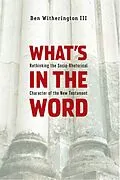Written in clear, and at times colorful, prose, Ben Witherington's What's in the Word explains how the recognition of the oral and socio-rhetorical character of the New Testament and its environment necessitates a change in how the New Testament literature is read. Expanding on the work in which he has been fruitfully engaged for over a quarter century, Witherington challenges the previously assured results of historical criticism and demonstrates chapter by chapter how the socio-rhetorical study shifts the paradigm.
Taken together, the chapters in What's in the Word coalesce around three of Witherington's ongoing academic concerns: orality and rhetoric; New Testament history, including issues of authenticity and canonicity; and the exegesis of given words in their canonical and socio-cultural contexts. Always unpredictable, this book never fails to pique interest and proffer instruction.
Autorentext
Ben WitheringtonIII
Inhalt
Invitation to the Dance
Chapter One: Oral Examination: How Did 'Oral' Texts Function in a Rhetorical Culture?
Chapter Two: Canonical Pseudepigrapha-Is It an Oxymoron?
Chapter Three: Rethinking and Redescribing Scribal Culture
Chapter Four: The Question of Sermons and Homilies in the New Testament
Chapter Five: Rom. 7.7-25- Retelling Adam's Tale
Chapter Six: What's in a Name? Rethinking the Historical Figure of the Beloved Disciple in the 4th Gospel
Chapter Seven: What's in a Word? Part One: Eidolothuton
Chapter Eight: What's In A Word? Part Two-Porneia
Chapter Nine: What's in a Phrase?-'No Male and Female' (Gal. 3.28)
Chapter Ten: Christianity in the Making': Oral Mystery or Eyewitness History?
Chapter Eleven: Rethinking the Canonizing of the New Testament
Chapter Twelve: Sign Posts along the Way-On Taking the Less Travelled Path
